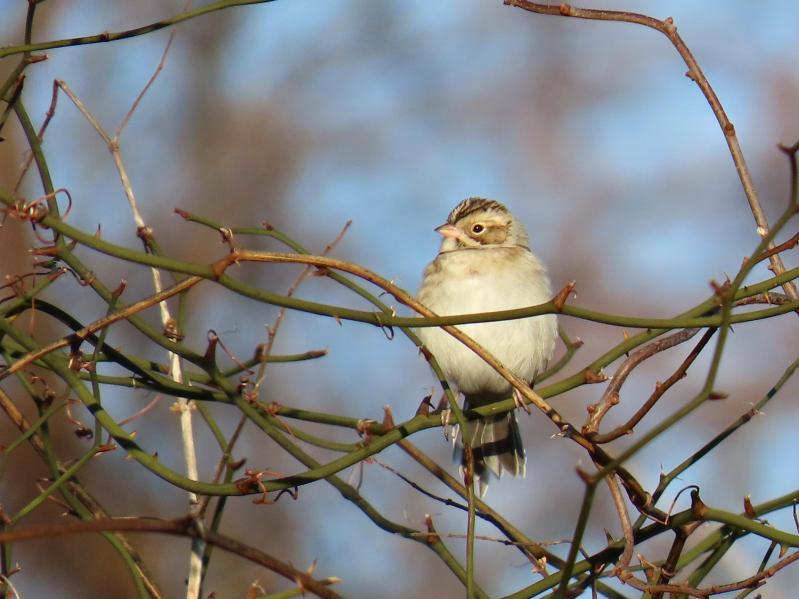Everyone was talking about the weather and how it was the best they had ever encountered on the 94th Audubon Montauk Christmas Bird Count, which took place on Dec. 16. Midday temperatures reached the mid-50s, and with light winds and clear skies, sunburned cheeks were the norm.
When darkness closed out the birding day and the species were tallied at the South Fork Natural History Museum, many of the 46 participants agreed that the good weather might have played a role in a high species total; 134 were found, the highest in a decade.
In a remarkable turn for a count with such history (the first was in 1920, but some years were missed), four birds that had never shown up in Montauk on the day of the count were spotted.
Perhaps the best was a tufted duck, swimming on Fort Pond. This stylish duck, named for a feather tuft that droops off the back of its head, breeds in Scandinavia and Siberia and is not usually found on this side of the Atlantic Ocean. It was first spotted by Shai Mitra and Patricia Lindsay on Dec. 2, and has made Montauk its home since. A rufous hummingbird on Napeague and a black-throated blue warbler on Gardiner’s Island were two other unexpected birds. A magnificent frigatebird that blew into Montauk following the crazy weather on Monday, Dec. 18, is considered only a “count week” bird, since it wasn’t present on the 16th.
Every December, Audubon organizes these counts across the United States. Each is contained within a count circle, 15 miles wide, that is named for the circle’s center. The Montauk circle is centered just north and west of Rocky Point, in Napeague Bay. Its westernmost territory spreads to Springs, and its easternmost is just short of Montauk Point, according to the Audubon website (a fact ignored by the many birders who sea watch up and down the Point all day). The circle is further divided into six territories: Point North, Point South, Lake West, Napeague, Accabonac, and Gardiner’s Island, each led by a birder who collects counts from participants in that section.
Birders tend to stick to the same section each year, getting to know it over time, and perhaps as a result, rivalries have developed among the territories. Fort Pond is in the Lake West territory of the count, so the tufted duck marked the second year in a row that Lake West had the “count bird.” (Last year, a trumpeter swan was found by Brent Bomkamp in the northern portion of the pond.)
But the Christmas bird counts aren’t about finding rare birds, or tallying the highest number of species. They’re simply about counting what birds are present, common or not, in an attempt to document species range and populations. The counts are one of the earliest and most enduring citizen-scientist projects. While the quality of the data varies based on many factors, such as the weather and the ability and number of birders participating, the consistency and amount of information gained over a long period makes them valuable.
A continuing multiyear trend was the dearth of bay ducks like scoters and common eiders. In the 1990s, tens of thousands of these ducks bobbed in great black rafts just off Montauk Point. They now are dotted about, with counts only a fraction of their historical highs.
But most of the news felt good. “Half hardy” species, like Carolina wrens, hermit thrushes, wood ducks, and greater yellowlegs, all had all-time high counts, perhaps because of the warmer weather, “A sign of how birds are being impacted by our changing climate,” Mr. Bomkamp, a co-compiler for the count, wrote in an email. Over 3,000 razorbills, a pelagic species closely related to penguins, represented a high count, as did 19 common ravens, and over 4,000 American robins, which also were counted in record numbers during the Orient Count on Dec. 30.
Of note were high counts for almost all woodpecker species, perhaps due to the number of dead trees in our area. “Where there are dead or sick trees, woodpeckers are soon to follow,” Andrew Stillman, an applied quantitative ecologist at the Cornell Lab of Ornithology who has researched woodpeckers for the last eight years, wrote in an email. “I think it is quite likely that the woodpeckers in East Hampton are benefiting from local insect outbreaks. We can help woodpeckers by leaving dead trees in place (when/where it’s safe) so they have places to feed and nest.”
Indeed, on the Orient bird count, a red-headed woodpecker (not to be confused with the poorly-named and common red-bellied woodpecker) was found by Bruce Horwith and Evan Schumann in Cedar Point County Park. A few days later, Margarette Doyle and Dermot Quinn found a second red-headed woodpecker in the same area. Perhaps 2024 is the year that the East End will finally host a pileated woodpecker, a crow-size bird more common in the north.
Other uncommon species found during the Montauk Count included a king eider just off False Point, a dovekie, an American bittern at Big Reed Pond, a clay-colored sparrow practically in the shadow of the Lighthouse, two yellow-breasted chats, and a northern parula, a type of warbler, west of Lake Montauk.
In the end, counting birds is simply a relaxing way to spend the day. Why not make it a New Year’s resolution to learn how to identify just 25 birds that make the East End their home? You can also make your home more friendly to birds by planting native shrubs, trees, and grasses, and installing Zen wind curtains.
The 2024 Montauk Count will take place on Saturday, Dec. 14, and volunteers are always needed.

